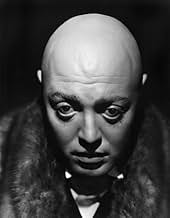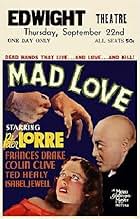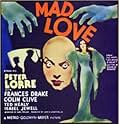Füge eine Handlung in deiner Sprache hinzuIn Paris, a demented surgeon's obsession with a British actress leads him to secretly replace her concert-pianist husband's mangled hands with those of a guillotined murderer with a gift for... Alles lesenIn Paris, a demented surgeon's obsession with a British actress leads him to secretly replace her concert-pianist husband's mangled hands with those of a guillotined murderer with a gift for knife-throwing.In Paris, a demented surgeon's obsession with a British actress leads him to secretly replace her concert-pianist husband's mangled hands with those of a guillotined murderer with a gift for knife-throwing.
- Auszeichnungen
- 1 Nominierung insgesamt
- Marie
- (as Sarah Haden)
- Chauffeur
- (Gelöschte Szenen)
- Undetermined Role
- (Gelöschte Szenen)
- Thief
- (Gelöschte Szenen)
- Marianne
- (Gelöschte Szenen)
- Undetermined Role
- (Gelöschte Szenen)
- Detective Arresting Stephen
- (Nicht genannt)
- Train Conductor
- (Nicht genannt)
- Stage Doorman
- (Nicht genannt)
- Taxi Driver
- (Nicht genannt)
Empfohlene Bewertungen
Mad Love is one of those amazingly old classics that is a hybrid of genre staples. At times it's surrealist and at others it's operating via a Grand Guginol pulse, whilst knowingly it laces the story with an uneasy comedic bent. Boasting camera work from Gregg Toland and Chester Lyons and directed by the impressive Karl Freund, this adaptation of Maurice Renard's novel is a chillingly memorable piece of work. Working off a plot that sees the bad Doctor driven by lustations rather than out and out insanity, Freund revels in slowly winding the coil until the spring that is Peter Lorre (Gogol) explodes (implodes), cloaking various scenes in telling shadows that themselves become integral to the plot. Peter Lorre is of course in his element, demented yet sympathetic, it's real hard to take your eyes away from his magnetic weirdness. Colin Clive as Stephen Orlac also puts in a performance of note, all twitchy nervousness and believable emotional torment, whilst Frances Drake more than adequately brings vulnerability to the centrifugal importance of Yvonne's emotional turmoil.
Weird and gorgeous, and incredibly well written, Mad Love holds up very well today as a horror/romance film of vast influential worth. So see it in the dark and marvel at its various moments of cinematic excellence. 8.5/10
"Mad Love" is the story of Doctor Gogol, brilliant Parisian surgeon whose reputation for doing surgeries on desperate cases free of charge is well- renowned. But Doctor Gogol is a morbid man as well, gleefully attending public beheadings and taking orgasmic delight in the Grand Guignol Theatre de Horreur, which stages realistic horror plays. The star of the Theatre is Yvonne, and Doctor Gogol is madly in love with her, hence the title of our film. But Yvonne is already married to Stephen Orlac, a famous concert pianist. Doctor Gogol, with his bald head and buggy eyes, gives her the creeps and her distaste for him is clear. However, when her husbands train crashes and his million-dollar hands are destroyed, it is Doctor Gogol she turns to. Desperate to win the love of Yvonne, Gogol agrees to do the impossible. Stephen Orlac is saved...but only Gogol knows that his hands are no longer his own. They once belonged to a killer, and they want to kill again.
Lorre turns in yet another astonishing performance here; his Gogol is very convincing, quite capable of handling a few lines of cornball dialogue without seeming foolish in the least. And the sympathy he elicits is simply amazing; I found myself cheering for him the whole time instead of for Yvonne, who struck me as a cold, opportunistic gold digger, quite willing to use the Doctor if it served her purpose. I'm sure this was not the intent of the filmmakers, but Lorre emerges as the hero here, at least in my humble opinion. Toward the end of the film, he is completely unleashed, playing mad, wild music on the organ and donning a most hideous metal contraption which looks like something that H. R. Giger might have designed.
This beautiful black-and-white film by MGM rivals the classic monsters of Universal, and placed Peter Lorre alongside such horror movie icons as Bela Lugosi, Boris Karloff and Vincent Price. Reportedly, Lorre detested these horror film roles that made him famous, but his resentment never shows through; he threw himself into this and every role with creativity and zeal. He is truly marvelous to watch. Mad Love should not be missed by fans of old, spooky Gothic tales. It is a masterpiece.
This is Lorre's entry into classic horror stardom: Karloff has his Frankenstein monster, Lugosi has Dracula (forever, folks), Chaney Jr. has the wolfman, and Lorre's got this lesser-known but equally classic film to recommend him as one of the major horror stars of the classic era. This film represents MGM's entry into the early 30s horror film sweepstakes as well, and they did well to associate themselves with solid hands like Freund's and Lorre's. Hands..... hmmmmm unintended pun. Anyway, if anyone out there is a fan of classic horror films and has not yet seen this one, put it at the top of your list.
En route, Mr. Clive's hands are wounded in a train wreck. Called in to operate, Lorre decides to amputate Clive's hands and sew on the hands of a recently decapitated murderer. Poor Clive loses his piano-playing ability, but gains other talents The whole "hand transplant" machinations never grabbed me or aided in my suspension of disbelief; but "Mad Love" is stylish, has Karl Freund directing, and Lorre is an amazing sight for sore eyes. Also watch for the Yvonne's maid Sara Haden (as Marie), who can really hold her own.
******* Mad Love (7/12/35) Karl Freund ~ Peter Lorre, Frances Drake, Colin Clive, Ted Healy
Wusstest du schon
- WissenswertesCharles Chaplin called Lorre the screen's best actor after seeing his performance in "Mad Love."
- PatzerThroughout the picture, the wax figure moves slightly whenever Frances Drake is subbing for the actual statue. Most noticeable when the bird lands on her shoulder, making the "lifeless" statue sway.
- Zitate
Françoise, Gogol's Housekeeper: [referring to the wax figure of Yvonne] It went out for a little walk!
- Crazy CreditsAt the end of the opening credits, the titles are painted on a glass window pane that is broken by a fist punching through it.
- Alternative VersionenPhil Hardy's The Overlook Film Encyclopedia: Science Fiction (p. 94) states that there is an 85-minute version of the film, although he provides no details about this.
- VerbindungenEdited into The History of the Hands (2016)
Top-Auswahl
- How long is Mad Love?Powered by Alexa
Details
- Erscheinungsdatum
- Herkunftsland
- Sprache
- Auch bekannt als
- Wahnsinnige Liebe
- Drehorte
- Produktionsfirma
- Weitere beteiligte Unternehmen bei IMDbPro anzeigen
Box Office
- Budget
- 257.502 $ (geschätzt)
- Laufzeit1 Stunde 8 Minuten
- Farbe
- Seitenverhältnis
- 1.37 : 1






































